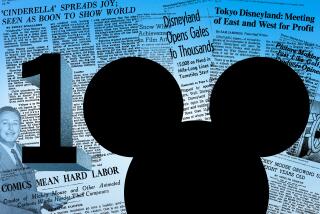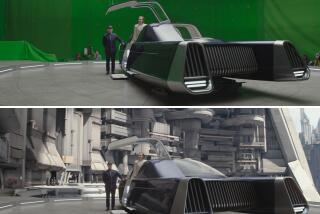Like a wily old wizard, ‘Dungeons & Dragons’ shows it has enduring magic
Next year marks the 45th anniversary of “Dungeons & Dragons,” the old-school tabletop game that — when compared to today’s video games — seems like a product of the Middle Ages instead of the mid-’70s.
But, like a wily old wizard, it’s easy to underestimate the brand and the scale of its enduring magic. “Dungeons & Dragons,” it turns out, is on a major dice roll in the Digital Age.
The role-playing game has posted record sales in back-to-back years, and for Hasbro, the toymaker that owns “D&D,” the brand’s future looks bright, with double-digit growth among first-time buyers this last year.
Banking on a dice-rolling game in an Xbox and “Call of Duty” era? It may sound like Hasbro is bringing a broadsword to a gun fight. But “D&D” doesn’t need to compete with video games (and could never rival its revenues). because the venerable fantasy game exists as a kingdom of influence in today’s pop culture. As a legacy brand, it’s the gaming equivalent of “Star Wars” or the Beatles — all three have a fandom torch that’s passed on generationally.
“People are more into ‘Dungeons & Dragons’ today than ever before,” Hasbro Chairman and Chief Executive Brian Goldner said on CNBC’s “Mad Money” in July. “People are re-engaged with that brand, because it’s a face-to-face game, it’s immersive and it’s a game that people really enjoy playing with one another.”
“Dungeons & Dragons” was a game-changer when it was introduced in 1974. Created by Gary Gygax and Dave Arneson, it was the first commercially available role-playing game, and its arrival launched the hobby-games industry, now a $1.4-billion annual business in North America alone.
Its game play concepts would have also provided core elements to electronic games. The most obvious heirs include “World of Warcraft,” “Final Fantasy,” “The Elder Scrolls” and similar sword-and-sorcery franchises among the “massively multiplayer” online games that directly follow the “D&D” tradition of transporting players into magical places in ancient times.
But the DNA of “D&D” is also encoded in any first-person shooter game (like “Call of Duty,” “Halo” or “Grand Theft Auto”) that sets players loose in an “openworld” where they have considerable freedom to roam, make choices and interact with others and objects.
More than 13 million people have roamed through the world of “D&D,” either in the tabletop version (the most recent new edition was released in 2014) or one of its namesake electronic iterations. Hasbro (which in 1999 bought “D&D’s” Seattle-based publisher, Wizards of the Coast) is gearing the brand up for new digital directions, and Goldner says the classic game is “ripe for eSports” ventures.
The company will be trying to catch up to its fans on that front. “D&D” matches (called “adventures”) already account for a thriving sector of Twitch, the online streaming-video site, which presents the action in real time with the added fizz of comedy commentary, as well as a visual feed of audience reaction and cross-talk. The end product feels like a celebrity poker game mashed-up with a table-read of “The Princess Bride,” with a campus comedy-club audience as the Greek chorus. On YouTube, “D&D” players share their recorded footage of heroic triumphs and epic fails the way they used to share skateboard stunt attempts.
Hasbro market research shows that half its first-time buyers are introduced to the game by seeing others play online and that many carry the tradition forward by recording and sharing their own adventures. Greg Tito, a Hasbro spokesman for the “D&D” brand, said the No. 1 entry point for newcomers to the game changed in 2017; before that, a parent or older relative was the most likely pathway, but now, the top recruiter is the game’s online presence. It’s also been enjoying some synergy in pop culture in recent years. One clear catalyst is the Netflix hit “Stranger Things,” which portrays it as a bond-building passion of the show’s young characters as they chase down paranormal mysteries in the Reagan era.
No surprise, Hasbro is also eager to see “D&D” follow in the silver-screen footsteps of its Transformers toys. The screen rights have been a tangled matter, which may be the only enduring legacy of the first “Dungeons & Dragons” movie, which fizzled in December 2000. The most recent word is that the toymaker and Paramount Pictures are ramping up a new feature film for October 2021 release.
The challenge facing any “D&D” film is one of the game’s greatest assets: Every match unfolds as a unique adventure and the characters are as varied as the players who choose and inhabit those roles in the fantasy realm of Izmer.
“It’s like the ‘Choose Your Own Adventure’ books,” says Tony DiTerlizzi, co-creator of “The Spiderwick Chronicles,” the fantasy bestseller that reached the screen in Paramount’s 2008 namesake film. “There isn’t one obvious story to tell. That’s the beauty of ‘D&D’ and the reason it sparks the imagination of players in generation after generation.”
DiTerlizzi should know. Hundreds of “D&D” pieces from his personal archive, including lavishly painted pieces used for 1990s game manuals and related publications were recently exhibited at the Norman Rockwell Museum in Stockbridge, Mass. The exhibit, “Never Abandon Imagination,” ended in May but is moving on to the Mint, a gallery in Atlanta.
DiTerlizzi’s “D&D” art is also collected in the hardcover book “Realms,” which joins an increasingly crowded shelf of “D&D” titles that range from how-to-play guides to more scholarly tomes. There also have been two “D&D” documentaries, all nodding to the cultural heft of the brand.
“D&D’s” Hollywood influence may still be underappreciated. Consider that filmmaker Jon Favreau (“The Jungle Book,” “Iron Man,” next year’s “The Lion King”) and “Game of Thrones” showrunner D.B. Weiss have each cited their childhood obsession with the game as a formative experience that still informs the world-building they now do for the screen. Dwayne Johnson, Vin Diesel, Drew Barrymore, Stephen Colbert, Patton Oswalt and Mike Myers also have a history with the game or still play it, only adding to the buzz in recent years. No surprise, characters on the hit sitcom “The Big Bang Theory” also play the game.
That kind of prime-time presence wouldn’t have worked in the 1980s, when “D&D” became a front in the culture wars amid media reports that suggested the tabletop game was a sinister influence with satanic themes. The reports didn’t amount to anything, but the furor did result in “Mazes and Monsters,” an overwrought 1982 television movie starring a young Tom Hanks as an unbalanced gamer.
“Mazes and Monsters” seems laughable in hindsight but Terlizzi remembers the chilling effect it had in “D&D’s” darkest hour. “We had a ‘Dungeons & Dragons’ club at my middle school and the game was getting more and more popular and then — poof! — it was all gone almost overnight, and parents thought it was devil worship. The success story now doesn’t surprise me at all; it’s really bringing it the level that it seemed destined for back when I was a kid.”
More to Read
Only good movies
Get the Indie Focus newsletter, Mark Olsen's weekly guide to the world of cinema.
You may occasionally receive promotional content from the Los Angeles Times.










